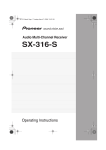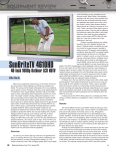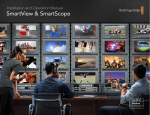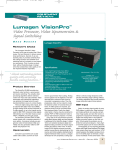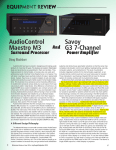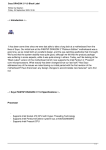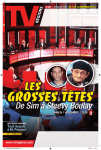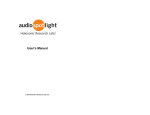Download to Issue 14 (July 2007)!
Transcript
WSRnewsletter14 7/23/07 2:34 PM Page 1 July 2007 • Volume 2, Issue 14 • The Official FREE Newsletter Of Widescreen Review Magazine WELCOME! Since Widescreen Review decided to combine the July and August print magazine into one, we thought it only right that we give you something extra special in this month’s August newsletter. Besides Part 6 of John Dunlavy’s seven-part archived loudspeaker design series of articles and our other regularly featured articles, we are including a number of DVD, HD DVD, and Blu-ray Disc reviews just like we do in the print magazine every month, as well as a product review of Monster’s AVL 300. One thing I have noticed as I read through electronic newsletter after electronic newsletter is that they all basically say the same thing. The same “news” is repeated over and over again in whatever online publication I happen to be reading at the time. I hope you have found that Widescreen Review’s free monthly newsletter is different from all the others and that you are enjoying the new content that we bring to you each month. Lastly, if you visit our Web site, and I hope you do, I think you’ll find we have made a few changes. Besides our new look, we have also added the Loudspeaker Buyer’s Guide. I look forward to your feedback. Gary Reber Editor-In-Chief, Widescreen Review NOW AVAILABLE ON NEWSSTANDS Issue 122, July/August 2007 of Widescreen Review: • “Niles StageFront Loudspeaker System” By Danny Richelieu • “Von Schweikert VR-4jr Full-Range Loudspeaker” By Peter Moncrieff • “Kaleidescape System: New 1U Movie And Music Server” By Danny Richelieu • “The 2007 Full-Range Loudspeaker Buyer’s Guide” • “HDMI 1.3 101” By Joel Silver • “Display Technologies — Part III: Plasma Displays” By Lancelot Braithwaite • Over 50 Blu-ray Disc, HD DVD, and DVD picture and sound quality reviews • And more... ATTRACTIONS 3 Web Exclusive Disc Reviews 5 Monster AVL 300—Home Theatre And Lighting Controller By Danny Richelieu 8 Wife Acceptance Forum By Tricia Spears 9 From The Archives: Loudspeaker Accuracy—How Room Acoustics And Loudspeaker Positioning Affect The Music, Part 6 By John Dunlavy WIDESCREEN REVIEW NEWSLETTER 14 1 JULY 2007 - www.WidescreenReview.com WSRnewsletter14 7/23/07 1:36 PM Page 2 WSRnewsletter14 7/23/07 1:36 PM Page 3 DISC REVIEWS www.WidescreenReview.com T h e R a t i n g Va l u e s GaryReber...(GR) Editor-In-Chief & Publisher The rating values apply to presentation (picture quality and sound quality) and to sourced critics’ reviews as a composite score (see Discography). Due to recent changes, some studios are no longer providing us with advance copies of their new releases. Please check our Web site at www.WidescreenReview.com for up-to-date reviews that may not be in the magazine. DannyRichelieu...(DR) Staff Writer JackKelley...(JK) DVD Picture/Sound Quality Score P4.0/S4.5 HD DVD Picture/Sound Quality Score P4.0/S4.5 Staff Writer, Research & Production Editor P4.0/S4.5 ▲ Blu-ray Disc Picture/Sound Quality Score C r i t i c s’ C o m p o s i t e S co re Fro m W S R ‘O g ra p h i e s ▲ EXCELLENT/Reference Quality...5 GOOD/Sure To Please...4 FAIR/Mediocre...3 POOR/Disappointing...2 UNACCEPTABLE/Not Recommended...1 ▲ S co re s TriciaSpears...(TS) ▲ Review Staff Managing Editor & Picture/Sound Quality Reviews CRITICS’ COMPOSITE 2.5 This logo provides a graphical method of quickly determining how active each loudspeaker is in a soundtrack. Red is for aggressive, Green is for moderate, Yellow is for weak, and White means the channel is not used. From top left, clockwise, the boxes represent the Left, Center, Right, Right Surround, Center Surround, and Left Surround channels, and the small box in the center represents the LFE channel. DRAMA Black Snake Moan P4.0/S3.5 P4.5/S3.5 P4.5/S3.5 CRITICS’ COMPOSITE 3.5 One never knows what he may find in the middle of a country dirt road, and God-fearin' Lazarus (Jackson) is no exception when he stumbles across the badly beaten town tramp, Rae (Ricci). Not sure what to do, he takes this scantily clad blonde back to his home to mend her wounds and get some meat on her bones. It is during her chain-monitored recovery that he discovers her soul is in desperate need of saving and calls in reinforcements to force the devil from her. Black Snake Moan made its 2007 debut at the Sundance Film Festival. Special features on both versions include commentary with Writer/Director Craig Brewer; the 28-minute making-of featurette; two musicoriented featurettes, The Black Snake Moan in nine minutes, and Rooted In The Blues in almost 13 minutes; five deleted scenes with optional Brewer commentary; a photo gallery; and previews, which are also shown upfront.JK While the anamorphically enhanced 2.40:1 DVD does show good depth of field, with solid blacks and well delineated shadows, details can be slightly soft and edges can look pixilated. Colors look good, with well-saturated, natural hues. Fleshtones are slightly too red, but only slightly, and contrast is balanced well. Edge enhancement is very minor and does not become a distraction. The H.264 AVC-encoded HD DVD and Blu-ray Disc both look fantastic, with deep blacks, good shadow delineation, and well-captured details. Colors are vibrant and realistic and skintones are natural. Differences between the two high-definition formats are negligible at best.DR The Dolby® Digital 5.1-channel soundtrack is rather basic, with little in the way of phantom imaging around the room. The front stage is adequate, though, for both music and effects. Dialogue generally sounds good, but it can be slightly boxy at times. The LFE channel is incorporated well when needed, and deep bass is present in the front full-range channels at times as well, but it is rare. The HD DVD's Dolby Digital Plus encoding sounds slightly more dynamic and fluid than the Blu-ray Disc's Dolby Digital encoding, but both have the same mix as the DVD, as well as the same problems.DR WSR Paramount Home Entertainment • Catalog Number 34619 (DVD); 13004 (Blu-ray Disc); 13003 (HD DVD) • R/2006/115 Minutes • Craig Brewer (Director) • Stars Samuel L. Jackson, Christina Ricci, Justin Timberlake, S. Epatha Merkerson, John Cothran, David Banner, Michael Raymond-James, Adriane Lenox, Kim Richards, Neimus K. Williams & Son House DOCUMENTARY One Six Right P3.5/S3.0 P4.0/S3.0 WSR SCORE 3.0 Sit back and soar into the vast blue yonder, and learn about the busiest general aviation airport in the world...the Van Nuys Airport in California. You will be amazed at the facts learned from this documentary, like Van Nuys has planes taking off or landing every 45 seconds during the day, making it busier than England's Heathrow Airport. And when you hear the controller announce, “Clear to land on One Six Right,” you know you're safe, you know you're home. Special features include five featurettes: Flight at four minutes, The Joyride II in a minute, two-anda-half minutes of Childhood Dreams, three minutes up in the clouds in They Call 'Em Clouds, and less than two minutes in Old Helmet & Goggles; some historical photos and production stills; and three deleted scenes. In addition to those, the HD DVD includes additional HD features: a three minute aerial footage featurette Into the Clouds, The Joy Ride III, a one-and-a-half minute aerial stunt footage featurette, and Movie Montage a 13-minute montage of footage from the film.JK The anamorphically enhanced 1.78:1 DVD shows vibrant, well-balanced colors and natural contrast, with well-rendered details and good shadow delineation. There are times in the interview segments where the subjects can look washed out, and generally all of them look slightly too pink skinned. Edge enhancement is a major problem that can really butcher many scenes. Original material and photographs look very good in the MPEG-2encoded HD DVD. Details are generally captured well, and the dimensionality of the images looks very natural. There are times when fine lines can show moiré artifacts, but it is not overly distracting.DR The Dolby® Digital 5.1-channel soundtrack generally sounds good, but the mix is typical of most documentaries. Dialogue is recorded well for the most part, but there are times when it can sound harsh and edgy. Music is generally mixed into just the corner full-range channels, with little imaging between the front two channels and little contribution from the surround channels. The HD DVD's Dolby Digital Plus encoding provides the same mix and dialogue intelligibility, with slightly improved dynamics and fidelity over the DVD's encoding. Still, the soundtrack is limited.DR WSR Terwilliger Productions • Catalog Number 11930 (DVD); 12170 (HD DVD) • G/2005/73 Minutes • Brian J. Terwilliger (Director) • Featured aircraft (in order of appearance) include Pitts S-2B, North American SNJ-5, Pitts S-2B, North American p-51, Douglas A-26, Piper J-3, Douglas DC-3, Fleet 7B, Cessna 414, Cirrus VK-30 & Cessna 172 COMEDY DRAMA Daddy’s Little Girls P3.5/S3.0 P3.5/S3.5 CRITICS’ COMPOSITE 3.0 Determined not to let his low-life ex-wife Jennifer (Smith) get custody of his three daughters, mechanic Monty (Elba) seeks help from hoity-toity attorney Julia (Union). As Daddy's working hard to get his Little Girls back home with him, Julia loosens up a bit and discovers that she's no better than him after all. Special features on the DVD and Blu-ray Disc include audio commentary with Director/ Writer Tyler Perry, an extended scene, previews, and three featurettes: Atlanta Aquarium: Working Underwater (two minutes...so, don't blink), Tyler's Team: Cast & Characters (14 minutes), and Introducing The McClain Sisters (four minutes). Additional features include the following featurettes: Touring The Sets (six minutes), Conducting Chaos: The Riot Scenes (seven minutes), and The Oakland Cemetery (five minutes); 16 deleted scenes; two gag reels; and three uncut scenes.TS The anamorphically enhanced 1.82:1 DVD can look good with well-balanced contrast and naturallooking fleshtones, but shadow delineation is slightly lacking, which can mask details in the darker scenes. Details, on occasion, can be slightly soft, and colors are slightly muted, especially greens. Some compression artifacts and moiré artifacts can be noticed from time to time, but edge enhancement is not overly distracting. The H.264 AVC-encoded Blu-ray Disc has the requisite increase in resolution as afforded it by the high-definition format, but some details are still soft and colors can be slightly muted. Shadow delineation is still underwhelming, and the image can look rather flat at times. The image is not bad, but it does have its problems.DR The Dolby® Digital Surround EX™ (although labeled Dolby Digital on the packaging and menus) 5.1-channel soundtrack has problems, with forwardsounding dialogue that also can be noticeably ADR produced. The mix is uninspiring, with little surround envelopment and little in the way of atmospheric ambiance. Music is mixed into the front left and right channels, but imaging across the front stage can be limited. The Blu-ray Disc includes a 7.1-channel uncompressed linear PCM encoding, which sounds noticeably more refined than the Dolby Surround EX encoding that is also included on the disc. The mix is still lacking, and the entire sonic character sounds rather thin. Dialogue can also sound fairly hard and edgy, and the center surround channels do not really add much to the surround envelopment.DR WSR Lionsgate • Catalog Number 21399 (DVD); 21403 (Blu-ray Disc) • PG-13/2007/100 Minutes • Tyler Perry (Director) • Stars Gabrielle Union, Idris Elba, Louis Gossett Jr., Tasha Smith, Malinda Williams & Gary Sturgis WIDESCREEN REVIEW NEWSLETTER 14 3 JULY 2007 - www.WidescreenReview.com WSRnewsletter14 7/23/07 1:36 PM Page 4 DISC REVIEWS www.WidescreenReview.com FANTASY ADVENTURE The Bridge To Terabithia P4.0/S3.0 P4.0/S3.0 CRITICS’ COMPOSITE 3.0 Jess (Hutcherson) has a tough life for a grade schooler. He has two older sisters who look down on him, and a younger sister that looks up to him, constantly (and annoyingly) by his side. His dad is less than understanding, and accepting, of his artistic abilities. Plus he is picked on by the school bully...who just happens to be a girl. But a breath of fresh air blows into his world in the form of Leslie (Robb), a pretty and free-spirited girl, that joins his elementary class, and becomes his next door neighbor. With her imaginative ways, she transports Jess away from his daily life to a far-away fantasy land found across The Bridge To Terabithia. Based on Katherine Paterson's Newberry Award-winning novel. Bonus features on both versions include two commentaries: the first with Director Gabor Csupo, Writer Jeff Stockwell, and Producer Hal Lieberman, and the second with Actors Josh Hutcherson and AnnaSophia Robb and Producer Lauren Levine; two Backstage Disney featurettes: Behind The Book: The Themes Of Bridge To Terabithia (15 minutes) and Digital Imagination: Bringing Terabithia To Life (six minutes); and the AnnaSophia Keep Your Mind Wide Open music video. The DVD includes previews, which are also shown upfront, while the BD adds a Movie Showcase.JK With well-captured details and good color saturation, the anamorphically enhanced 1.85:1 DVD looks very good. Black levels are deep, and when combined with the very good shadow delineation it can make for a very dimensional looking image. Fleshtones look very natural. Edge enhancement can be a problem at times, and pixel breakup can also be a distraction. Compression artifacts are also noticeable. The H.264 AVC-encoded Blu-ray Disc also shows deep blacks and very good shadow delineation, and with its slightly over-enhanced contrast it makes for a very dimensional-looking image. Fine details in close shots are captured well, but medium and long shots are slightly soft. Fleshtones have a slightly pinkish hue.DR The Dolby® Digital 5.1-channel soundtrack can be exciting, with each of the available channels used effectively, but a hissing distortion can be heard at times throughout the presentation, and dialogue can sound forward, both of which can be very distracting. The Blu-ray Disc's uncompressed linear PCM 5.1channel soundtrack also has problems with the dialogue and distortion in some of the canned effects. Dynamic range is limited, and a high-pitched hiss can be heard, but the mix is enveloping.DR WSR Walt Disney Home Entertainment • Catalog Number 52372 (DVD); 54248 (Blu-ray Disc) • PG/2006/95 Minutes • Gabor Csupo (Director) • Stars Josh Hutcherson, AnnaSophia Robb, Robert Patrick, Bailee Madison & Zooey Deschanel THRILLER Primeval P3.0/S4.0 P4.5/S4.0 CRITICS’ COMPOSITE 2.0 If you're ever in Africa and decide to take a dip in a nearby river, use extreme caution. Extreme. You see, there's this Primeval croc, that goes by the name of Gustave, and he's hunting, and he's hungry. And, unfortunately, an American film crew has ventured into the remotest parts of Africa in search of him, determined to stop this heart-stopping killing machine. This tale, scary enough, is inspired by true events. Special features on both versions include commentary with Director Michael Katleman and Visual Effects Supervisor Paul Lindden, three deleted scenes with optional commentary, and the nine-and-a-half-minute Crocumentary: Bringing Gustave To Life featurette. There are also up-front previews. The BD also has a Movie Showcase.JK/TS The anamorphically enhanced 2.35:1 DVD is rather soft, with fine details difficult to make out. Once reaching Africa, the color scheme becomes very hot in daytime scenes, and, in my opinion, the filmmakers overdid it in this regard, as the imagery looks completely unnatural. At night the colors are much more realistic, but still slightly muted. Edge enhancement is noticeable, but is not overly distracting. The H.264 AVC-encoded Blu-ray Disc is a marked improvement, with much greater detail and a somewhat more believable color scheme. Black levels are deep and shadow delineation is good, making for an enjoyable experience. Some of the computer generated moments can look noticeably different from live action, which can be a minor distraction.DR The Dolby® Digital 5.1-channel soundtrack can be very lively, with each of the full-range channels used often with good localization of effects around the room. Dynamic range is good, and even in the most intense scenes subtle effects and low-level dialogue can still be heard. Fidelity is not perfectly natural, and there are times when the audio can sound rather digital and unrefined. The Blu-ray Disc's uncompressed linear PCM encoding is also enjoyable, with an exciting mix and good overall fidelity. Dynamic range is rather impressive, but dialogue can occasionally sound artificial and a hissing distortion can be heard at times.DR WSR Walt Disney • Catalog Number 53739 (DVD); 53674 (Blu-ray Disc) • R/2006/94 Minutes • Michael Katleman (Director) • Stars Dominic Purcell, Orlando Jones, Brooke Langton & Jurgen Prochnow HORROR The Messengers P4.0/S4.5 P4.0/S4.0 CRITICS’ COMPOSITE 2.0 In The Messengers, Roy (McDermott) and Denise (Miller) move their family from big city life Chicago to the quiet beauty of a North Dakota sunflower farm. But life turns anything but tranquil for teenaged daughter Jess (Stewart), when she and her brother Ben (Evan & Theodore Turner) are witness to disturbing visions that her parents aren't able to see. Special features on both versions include: commentary with Kristen Stewart & Guests, the seven-part Exhuming The Messengers in 38 minutes, and previews (which are also shown up front).TS The stylized, anamorphically enhanced 1.85:1 DVD exhibits a pleasing image with solid blacks and good shadow delineation. Details can be slightly under-defined at times and contrast can be slightly too bright in the daytime. Colors are slightly undersaturated, which matches the story well. Edge enhancement is noticeable, but generally only on high-contrast transitions. The H.264 AVC-encoded Blu-ray Disc shows well-captured details and maintains the solid blacks and shadow delineation. The imagery can look rather deep, and contrast seems to be slightly more realistic in daytime scenes. Some color banding can be noticed at times, and occasionally scenes can look too digitized.DR The Dolby® Digital 5.1-channel soundtrack can be very lively, with each of the full-range channels incorporated to create a well-defined sonic landscape. Dialogue is well-recorded and played back. The LFE channel is used well to help build suspense, and deep bass is delivered in each of the available channels. The mix is exciting, which helps move the story along well. The Blu-ray Disc's uncompressed linear PCM 5.1-channel encoding is enjoyable, with the exciting mix teamed with good dynamic range and articulation. Dialogue can sound slightly too forward, out of place with the rest of the front stage's sonics.DR WSR Sony Pictures• Catalog Number 14850 (DVD); 19061 (Blu-ray Disc) • PG-13/2006/90 Minutes • Danny Pang & Oxide Pang (Director) • Stars Kristen Stewart, Dylan McDermott & Penelope Ann Miller DRAMA Blood Diamond P3.5/S4.5 Critics’ Composite 3.5 Warner Home Video • Catalog Number 111767 • R/2006/143 Minutes • Edward Zwick (Director) • Stars Leonardo DiCaprio, Jennifer Connelly, Djimon Hounsou, Jimi Mistry, Michael Sheen & Arnold Vosloo Previously reviewed in Issue 120 on DVD. Special features are the same as on the DVD. The VC-1-encoded 2.38:1 Blu-ray Disc can look very good, with bold colors and good resolution. Outdoor scenes can be overly contrasted at times, but not consistently so, and some of the darker scenes can look artificially flat. In general, the image is good, but not consistently so.DR The uncompressed linear PCM 5.1-channel soundtrack features very good fidelity. There are moments where dialogue is too obviously ADR-produced. Phantom imaging is incorporated well around the room, which really brings life to the soundtrack.DR WSR WIDESCREEN REVIEW NEWSLETTER 14 4 THRILLER Breach P3.5/S3.5 Critics’ Composite 4.0 Universal Studios • Catalog Number 61032405 • PG-13/2006/110 Minutes • Billy Ray (Director) • Stars Chris Cooper, Ryan Phillippe, Laura Linney, Dennis Haysbert, Caroline Dhavernas, Gary Cole, Bruce Davison & Kathleen Quinlan Previously reviewed in Issue 122 on DVD. Special features are the same as on the DVD. The highly stylized VC-1-encoded 1.78:1 Blu-ray Disc looks muted and flat for the most part, and while details can be captured well, there are times when they are slightly soft. Edge enhancement can be seen in this release, but is not as drastic as in the DVD.DR The Dolby® Digital Plus 5.1-channel soundtrack features good fidelity and a very low noise floor, making for a believable experience. The mix is slightly lacking, though, with little use of the surround channels and a rather narrow front stage.DR WSR JULY 2007 - www.WidescreenReview.com WSRnewsletter14 7/23/07 1:36 PM Page 5 EQUIPMENT REVIEW Monster® AVL 300 Home Theatre And Lighting Controller Danny Richelieu Introduction gentle curves across the width in the middle of the remote and behind the LCD. The curve across the middle is in a perfect place for resting your index finger (holding it with either the left or right hand), and puts the most accessed buttons (fast forward/reverse, play, pause, record, volume, channel, guide, etc.) within thumb-pressing distance. The remote has a soft, almost rubberized feel to it that is very comfortable. Overall, the remote is easy to hold and is laid out well. The remote includes 43 hard buttons, plus another eight buttons that correspond to rows on the LCD screen. Tilting the remote automatically turns on the AVL 300’s backlight (a feature that can be defeated in the settings), which is very effective in making every button visible in the dark. When I first received an AVL 300 for review, there were problems with the way it charged, as the metal leads that connect the remote to the charger did not seem to make a clean connection. I assumed this was a design flaw, but recently a new firmware version was released that seems to have fixed the problems I had with charging the remote, and it wasn’t a hardware design flaw after all—very good news. As Monster® continues its evolution from a cable company to a complete home theatre solution provider, they have released their first high-performance “universal” remote controller, sold under the sub-brand Monster Central Control Systems—the AVL 300. The AVL 300 is more than a typical universal remote, as it can also control your home’s lighting, when paired with Monster’s IlluminEssence™ lighting system. Changing out your home’s light switches with these Z-Wave-powered in-wall dimmers and switches (In-Wall Light Dimmer System 600—doesn’t exactly roll off the tongue—and In-Wall Switch, both about $130) and adding plug-in dimmers and switches to lamps (Light Station Dimmer and Light Station Switch, $100) will link your home’s lights into a strong mesh network (for more information on Z-Wave technology, visit http://www.z-wave.com). Monster will be the first to admit that they needed help in designing and building these switches and dimmers, so they went to Leviton, the company that has been involved in lighting since its inception in 1906. Monster’s IlluminEssence lighting system has been designed to be capable of even more advanced features beyond the AVL 300’s capability in regards to remote monitoring and two-way broadcasting. Onboard memory is included in the dimmers and switches, which can provide more advanced scene functionality directly from the switches and dimmers to be accessed without the need for a remote. These features were not “live” as of press time, but Monster has announced plans to incorporate them in the future. Monster has also promised that software improvements are forthcoming to improve the AVL 300’s functionality in regards to lighting (and A/V device control as well), and additional AVL 300 controllable Z-Wave-based devices will be arriving soon, including controls for window shades and ceiling fans. And to ensure that their remote would be compatible with as many products as possible, they partnered with Logitech, makers of the popular Harmony universal remote controllers, harnessing their huge database of IR remote codes for home entertainment equipment. Monster’s relatively easy-to-use PC and Mac OS X-compatible setup software is also mainly from Logitech. The AVL 300 sells for $500 and does not come with any switches or dimmers for controlling your lighting. Installation Before beginning an on-screen (the remote’s screen) tutorial, you must charge the remote; the very basic installation/user manual does not provide a suggestion for the length of time it should be charged, but you might as well wait until it is full (it took about an hour for me). The remote’s 1.25- x 1.5-inch LCD screen has a battery charge level indicator in the top right-hand corner. After charging, the remote’s Aesthetics The AVL 300 has a “candy bar” shape, or in other words, it’s (roughly) a 2- x 0.75- x 8-inch box. The back of the remote has WIDESCREEN REVIEW NEWSLETTER 14 OmniLink 5 JULY 2007 - www.WidescreenReview.com WSRnewsletter14 7/23/07 1:36 PM Page 6 EQUIPMENT REVIEW Monster AVL 300 WIDESCREEN REVIEW NEWSLETTER 14 6 General Included: AVL 300, OmniLink (RF to IR converter), 4 IR emitters (for controlling up to 8 components), USB cable, Charging cradle, Installation software CD, User manual LCD Screen: 1.25 x 1.5 inches Hard buttons: 51 Backlight: Full controller, motion sensitive Dimensions (WHD In Inches): 2 x 0.75 x 8 Weight (In Pounds): 4.85 Price: $499.95 Manufactured In China By: Monster Cable, LLC 455 Valley Drive Brisbane, CA 94005 Phone: 415 840 2000 Fax: 415 468 0311 www.monstercentral.com SPECIFICATIONS short tutorial helps in familiarizing the layout of the remote and the locations of key buttons. The Internet-enabled setup guide (a CD-ROM is included with the AVL 300, containing both the PC and Mac OS X versions of the software) is fairly easy to use and very intuitive. After setting up a login and password (both for protecting your codes and accessing online help and firmware updates), you link the remote and OmniLink RF-toIR converter and IR blaster to each other. The OmniLink box—which is included with the AVL 300—allows you to control components that are housed behind a door or even in another room, even if they do not have an RF emitter built in (most components are limited to the “line-of-sight” limited IR). But the OmniLink is not just an RF to IR bridge, it also houses 65 percent of the commands that are found in the AVL 300 itself, meaning it stores the IR codes for the AV components that are connected to it, so it can manage the state of the devices internally to minimize conflicts and to create a more robust multi-room system. The AVL 300 also comes with four ControlLink™ IR emitter dongles that each have emitters for two components. And, when coupled with the OmniLink, the AVL 300 has an RF range of up to 130 feet, making it one of the most powerful RF remotes on the market today. The AVL 300 can be mated with up to six OmniLinks, and up to six AVL 300s can be configured into the same network. This is incredible flexibility to find in a hand-held remote control system, with the ability to truly provide whole-house control. Giving the AVL 300’s Remote Assistant (the controller’s built-in help) as much trouble as I could, I started having problems pairing the OmniLink to the system, but it was relatively easy to get myself out of trouble when the Assistant failed. Monster includes a Customer Service department phone number on the AVL 300’s packaging if you need additional help, as well as help sections on the www.monstercentral.com Web site and directly within the Monster Central Control setup and installation software. After telling the software what equipment is in the room by selecting from their impressive list of manufacturers and typing in the model numbers or names, you can set up Activities (macros that automatically tune the TV, pre-amp or receiver, and any other devices to the correct inputs and power states) and add lighting scenes (if you have installed any IlluminEssence lighting controls). The setup system is very easy to follow and understand, holding your hand through the entire process. It isn’t the most powerful of installation/setup programs that I have used, but it is functional. Next you can add the IlluminEssence lighting dimmers and switches and set up Lighting Scenes. These allow you to set the levels and on/off states of all the connected lights with the press of a button. With dimmers, you can set the percentage light level you would like for the light, and with both the dimmers and switches you can set whether the light is on or off, creating a very dramatic—as well as affordable and easy—controlled lighting system in your home. After setting the remote and lights up, a process that took about two hours, including the time it took to install the in-wall dimmers (remember to shut off the power), almost everything worked perfectly. The lights were all easy to control, and the activities worked well. The commands were a little bit slow in delivery, but the lag time can be adjusted if you go back to the component page in the installation software. The remote can control a large number of components—I gave up after adding 31 bogus devices. The AVL 300 did not properly control my ADA preamp with the “Best possible remote codes” that it automatically selected, so I had to program in the individual codes from the remote by hand. This process was very easy, although it could get slightly cumbersome. Going to the Modify Settings page in the installation software, then selecting the component you want to modify brings you to a page with 13 options for changing the device’s settings, including renam- ing the device, adjusting inputs, adjusting remote delays, and learning infrared command codes. Going to the “learning” page brings up a list of the Recommended and Optional Commands, with a box on the bottom of the page that allows the user to add New Commands that are not in either of the two lists. For my processor, there were many commands that I use often that were not in the lists, and adding them was an easy process. With the remote connected to the computer via the provided USB cable, you simply hold the component’s original remote about two inches from the bottom edge of the AVL 300 (where an IR receiver is located) and press the button you want it to learn. New Commands can only be learned one at a time, which can make the process cumbersome if there are many codes you want to teach it. Also in the Device Options page is the option “Customize the Device Mode,” where you can edit the commands that are accessible by pressing 37 of the hard buttons on the remote, as well as the commands that can be associated with the eight hard buttons that flank the LCD screen, four on each side. As many “pages” of commands (eight or four—depending on the AVL 300’s settings—commands are on a page) can be stored as needed, and the Page Left and Page Right buttons below the LCD on the remote make navigating through the pages easy. This customization is very helpful, and the easy-to-read labels on the LCD screen make it painless for anyone to use the device’s remote commands without needing additional coaching. From the installation software you can also change the LCD screen’s background image (using any properly sized JPG image on your computer) and add a JPG slide show that can be played on the remote’s screen (although the screen will still turn off when inactive, as it always does, even with the slide show running). Lighting When combined with IlluminEssence lighting dimmers and switches, the AVL 300 becomes a very powerful device. A large number of JULY 2007 - www.WidescreenReview.com . WSRnewsletter14 7/23/07 1:36 PM Page 7 EQUIPMENT REVIEW . Monster AVL 300 The AVL 300 can also control Lighting Scenes, which will turn on, turn off, or dim to a preset brightness percentage any of the lights that the remote is controlling with the press of a single button. You can also tie these Lighting Scenes to Component Activities to adjust all of the components and lights for a given activity with the press of a single button. In my house, I set the Watch A DVD Activity to turn on the TV, preamp, and amplifier, switch to the correct input on the TV and preamp, and then turn off all of the lights in the theatre, while bringing the lights in the kitchen to 30 percent brightness and turning off the rest, all with the touch of one button. And it worked flawlessly. AVL 300 In Charging Cradle Conclusions lights can be controlled by the system (I stopped at 50), and being controlled by Z-Wave technology, the lights can be turned on, turned off, or dimmed from anywhere in the house. Each lighting switch or dimmer (plug-in or in-wall) acts as a “node” for the mesh network, meaning the controller’s range expands as you add more switches and dimmers, making it possible to easily cover an entire house if needed. The AVL 300 did exactly what it was supposed to do in conjunction with the dimmers and switches, and the simple setup and installation gave me full-house lighting control within hours without the need of a custom installer. This is definitely a “must have” for that doit-yourselfer who wants whole-house lighting control. The AVL 300 is a fantastic universal remote that can provide complete control for all of the A/V devices in your home, as well as all of the lights. It is very easy to operate and set up, and doesn’t have many hiccups in its operation. The button layout is well mapped, and it is a very comfortable remote to hold. It is easily customized, and with its huge database of remote codes, adding new devices to the controller is a simple, straightforward process. Even when the remote codes it suggests do not work, adding the correct codes is relatively pain free. The price is a little high ($499.95 without any lighting dimmers or switches) for a universal remote without a touch-screen LCD interface, but it is one of the only hand-held devices available that can perform lighting control. The build quality is generally solid, but the protruding Select button in the middle of the remote does seem slightly flimsy, and could pop off if the AVL 300 is not properly handled. Overall, this is a great product that will make your home theatre experience more enjoyable. If you want to add universal control to your components, and lighting control to your house, the AVL 300 is definitely worth an audition. And to make things even better, the AVL-300 is having a $399.95 factory special pricing during summer 2007 (yeah, right now). WSR Component Activities And Lighting Scenes The AVL 300 includes the ability to set Component Activities or macros for turning on and off specific components in your house with the single push of a button. You can set up Activities for things like Watch A DVD, Watch TV, Listen To A CD, or whatever else you might want to do, and you can program the remote to automatically turn on the correct components and switch to the correct inputs for any of the devices in your home. The Component Activities worked very well for me, and I didn’t run into a single problem after properly setting them up. SUBSCRIBE NOW! TO WIDESCREEN REVIEW Print Subscription Special One Year—12 Issues U.S. - $34.00 Canada/Mexico - $40.00US International. - $55.00US All pricing includes shipping. Two Year—24 Issues U.S. - $60.00 Canada/Mexico - $70.00US International - $100.00US All pricing includes shipping. Online Subscription Special 12 Month Access $15.00 24 Month Access $25.00 To Subscribe Go To: www.WidescreenReview.com/subscribe WIDESCREEN REVIEW NEWSLETTER 14 7 JULY 2007 - www.WidescreenReview.com WSRnewsletter14 7/23/07 2:34 PM Page 8 Tricia Spears Wife Assistance Forum Just another day in Paradise. As I sit here Under The Tuscan Sun looking out at hillsides filled with vineyards, I’m feeling a tiny bit guilty that I’m not at work. But only a tiny bit. In an attempt to ease some of the guilt, I thought I’d get started on my column. Here in a beautiful villa just outside of Greve, Italy, with my husband, son, and a group of my nearest and dearest friends, it’s easy to forget about home theatre land back home...sort of. There are no big flat panels hanging on the walls, no in-walls, no on-walls, and no loudspeakers outside where I’m sitting. The only television in the place is a 24-inch CRT Sinudyne (what the heck is that?!), and for audio we have some old Sony mini system. There is some beautiful music playing inside, however (which could sound a little better, admittedly), the windows are open, and the tunes are making their way out here. Life just doesn’t get much better than this. Before I left home I went on a little field trip. I drove out to Costa Mesa, California to visit with Mike Sisco of Customworks, Inc. Mike opened his store in 2002, and he says that business is booming. He told me something about his clientele, though, that I think many of you will find quite surprising, if not disturbing. He said that the majority of his customers care more about appearance than performance when it comes to home theatre. And I’m pretty sure his customers aren’t all women. But hey, this is The OC we’re talking about, after all. The purpose of my visit was to check out the Artcoustic™ Loudspeakers that Mike has on display in his demo room. I first learned about Artcoustic of Denmark when John Caldwell of St. John Group and Peter Hoagland paid a visit to Widescreen Review. Among the things they brought with them was Artcoustic’s 2007 fullline brochure. Fascinated by what I was looking at on paper, I decided that I just had to see—and hear—what these loudspeakers had to offer. Customworks is located in a large industrial block of businesses, next to Orange County’s John Wayne airport. And I do mean, right next to it. I didn’t go upstairs where the various offices are located, but downstairs, next to the reception area, is a small demo room with the Artcoustic loudspeakers on display. Mike had them already in “Play” mode when I arrived, and they were sounding quite impressive indeed. But what really got me excited was the way they looked. Not only do these loudspeakers pack a lot of performance, they offer the best of both worlds—performance and appearance! At first I didn’t realize I was even looking at loudspeakers. On each side of the flat screen TV hanging on the wall was a loudspeaker, which, in actuality, looked like a pair of beautiful paintings, and below the television was a white subwoofer. The loudspeakers come standard in either white, black, or grey grill cloths and as their catalog shows, there is a large selection of artwork available that can be substituted for the solid color grill cloths. Additionally, if a customer has a favorite picture or photo they would like to use instead of one in the Artcoustic catalog, this is available as an option at no extra cost. Just think, you could change the looks of your loudspeakers to go along with whatever season it happens to be. ‘Tis the season? Put up a wintry Christmas scene. Relatives in town? Throw up one of the family photos. Or if you happen to be in a plain kind of mood, exchange your paintings for the solid color grills that are included along with the custom options. WIDESCREEN REVIEW NEWSLETTER 14 Wish the woman in your life would show a little more empathy, or at least a tiny bit of enthusiasm, when it comes to your passion for home theatre? If so, send her my way, [email protected], and I’ll be happy to try and clear up any questions or concerns that she may have (in a language that she’ll even be able to understand). Besides loudspeakers and subwoofers, Artcoustic also makes a stylish, contemporary storage cabinet that Customworks also had on display. And their Media Wall is an innovative new product that is designed to hide flat screen and loudspeaker cables, available in a standard black or white finish. Mike wanted to show me the system set up in a house he had recently completed. So off we went to the home of Ryan Heuser, one of the co-founders of Paul Frank Industries. You know, creators of that cute little monkey Julius that you see on so many articles of clothing these days. This was the first job that Mike had completed with Artcoustic loudspeakers where he actually installed them directly into the wall, rather than hanging them on the wall. With the standard white cloths that Ryan chose to go along with the rest of his very modern décor and the flush look of the frame, this was a very different and impressive look. Of course, I had to be nosy and take a good look around the whole house. Inside the closet in the exercise room, Mike had installed all of the audio/video equipment, hiding it out of sight...a very nice touch for sure! And outside, after crossing over a bridge under which swam a group of beautiful koi, there was a backyard worthy of some serious entertaining. The outdoor system is sure to be a hit at any party. I’m feeling a little less guilty now, and I think I’ll take a walk with the group up to the winery above us. But before I go, I just want to mention one more thing. While I was going through airport securities, sitting in lounges, and looking at people using their laptops on the plane, something hit me. With all this constant talk about the battling HD DVD and Blu-ray Disc formats and the comparison to the VHS and Betamax days, I thought of another parallel. Macs vs. PCs. I was witnessing people using both. Some people prefer Macs, others prefer PCs. Guess what? There’s room in this world for both. Maybe it’ll just have to be the same for HD DVD and Blu-ray Disc. Ciao! WSR 8 JULY 2007 - www.WidescreenReview.com WSRnewsletter14 7/23/07 1:36 PM Page 9 FROM The Archives Loudspeaker Accuracy How Room Acoustics And Loudspeaker Positioning Affect The Music — Part 6 J O H N D U N L A V Y This is the sixth article in a series on the topic “Loudspeaker Accuracy” that I have written for Widescreen Review as a guest editorialist. In this article, I will cover room acoustics and loudspeaker positioning within the room. Introduction A lot of popular misconceptions exist concerning listening rooms, the proper placement of loudspeakers with respect to room boundaries (walls), and the overall best listening position within a room. Many an audiophile have fallen prey to such misconceptions and friendly (but poor) advice, only to end sadder but wiser by the experience. Indeed, a listening room with good acoustics is usually a blessing and a source of continuing enjoyment for any serious audiophile. By contrast, a listening room with poor acoustics can represent a stressinducing challenge, requiring a combination of patience, understanding, ingenuity, resourcefulness, and a lot of perspiration. Likewise, poor placement of loudspeakers within the listening room can seriously degrade the sound quality and imaging of even the most accurate loudspeakers. A good start to understanding your listening room is to examine how the hearing process works, how various attributes of a listening room (size, shape, resonance modes, sound-absorbing surfaces, etc.) affect its sound qualities, and how different loudspeaker locations within the room can significantly alter the perceived realism of well-recorded music, reproduced by an accurate audiophile system. What And How We Hear Those audiophiles blessed with reasonably good hearing and relevant listening experience are usually able to discern whether sounds reproduced by their stereo WIDESCREEN REVIEW NEWSLETTER 14 or multichannel system match those of a “live performance” with acceptable realism, when listening to accurately recorded music or movies. But even the most accurate audiophile systems are always dependent upon room acoustics and proper placement of the loudspeakers within the room, relative to the room boundaries (walls, doors, etc.) and the primary listening position, if truly accurate reproduction and stereo imaging between two loudspeakers are to be achieved. Indeed, to achieve accurate imaging, it is absolutely necessary that the front stereo loudspeakers (or for that matter, the side and back wall stereo pairs) be located precisely equidistant and equiangularly from the listener. Otherwise, “center stage” sounds will be heard as being either “offcenter” or “diffuse.” Anyone who claims otherwise has never heard a pair of truly accurate loudspeakers properly set up within a good listening room. For example, a mismatch of only about 1 dB in amplitude between a pair of stereo loudspeakers can shift the apparent location of a “center stage” sound by about 10 degrees. For those possessing a “sound level meter,” such as those available from Radio Shack, etc., a source of mono broadband noise (an FM tuner tuned off-station) can be used to assist in accurately locating loudspeakers. When a stereo pair of loudspeakers are located precisely equidistant and equiangular from the listening position, a nearly 3 dB rise in amplitude will be observed within the space of a few inches. When this is achieved, excellent imaging should be heard from a pair of accurate, well-matched loudspeakers. Our human hearing process is truly amazing with respect to the range of acoustical properties it can discern, quantify, analyze, and determine to be satisfying or annoying. Although not everyone is born 9 with or retains near-perfect hearing, most of us possess a level of hearing acuity that permits us to readily determine the quality and realism of music being reproduced by an audiophile system. Several different attributes and features of our hearing provide us with an ability to evaluate whether our audio system sounds realistic, good, pleasant, etc. The more important of these attributes are: 1. Frequency Response (Spectral Balance) Those audiophiles whose hearing (amplitude response) is reasonably good over the entire audio range generally possess a better ability to discern whether their audio system exhibits a good “spectral balance.” However, despite the popular notion that most people can hear musical sounds up to about 20 kHz, the truth is that less than about one-fourth to one-third of America’s population can hear sound (of reasonable amplitude) above about 10 kHz. Based upon recent surveys, many young people who regularly listen to rock music at SPLs exceeding 105 dB possess a usable frequency response limited at the high-end to about 7 kHz—a truly sad commentary regarding our present culture. (Indeed, it has been estimated that less than about 10 percent of the total population can actually discern sound at frequencies up to 20 kHz.) Generally speaking, most experienced audiophiles can discern an audible difference between a loudspeaker with a (plus or minus) ±1 dB amplitude vs frequency response (using time-aligned drivers and a first-order crossover network) and one with a ±3 dB response when listening to audiophile-quality recordings within a reasonably good listening environment. 2. Transient Response (Fusion Time) Whether a sound reflected from the walls, floor, or ceiling of a listening room is “heard” by a listener as an “echo,” an alteration in JULY 2007 - www.WidescreenReview.com WSRnewsletter14 7/23/07 1:36 PM Page 10 FROM The Archives spectral balance, or as a blurring of musical transients is related to what is called the “fusion time” of our hearing process. Fusion time is the separation in time between two short duration pulses, measured in milliseconds, for which the sound is no longer perceived as a single “pulse,” but as two separate pulses. This may range from a short 4 milliseconds (4/1,000 of a second) to as long as 15 milliseconds, depending upon the hearing acuity of the individual. Generally, this corresponds to a delay between any given direct and reflected path of from about 4.5 to 17 feet (or 4 to 15 milliseconds). If the reflected component of any transient type sound arrives within this fusion time, it will usually be perceived as either a blurring of musical transients (perhaps, turning a “tic” sound into a “toc,” or a drum “snap” into a “boom”), or an alteration in spectral balance if the music contains mostly “sustained” notes such as organ sounds. However, if the delay between direct and reflected sounds substantially exceeds the fusion time, the effect is more likely to be perceived as transients becoming “separate tics” or organ notes acquiring a short delayed echo. Either way, reflected sounds frequently result in an unacceptable degradation in sound quality and must be dealt with by covering or treating offending wall, ceiling, or floor surfaces with materials that exhibit appropriate acoustical absorption properties. 3. Sensitivity (Low Level Threshold) To begin, imagine a room of arbitrary size with stereo loudspeakers at one end and a listener at the opposite end. In addition to the “direct path” sound, the listener hears sound energy reflected from the wall surfaces behind the loudspeakers, the two side walls, the ceiling, the floor, and the wall behind the listener. Each of these “reflected sounds” arrives at the listener’s ears with a time delay related to the length of the path taken by the sound, traveling at a velocity of about 1,140 feet per second (approximately 13.7 inches during each 1/1,000 of a second). In a home theatre, ideally the principal viewing and listening position would be equidistant from all five (or six if your system supports a center back surround channel) loudspeakers, and at equal angles relative to the listener. Depending upon the delay times encountered by the reflected sounds, and whether the original sound consisted largely of continuous tones (organ notes) or of transients (plucked strings, etc.), the listener may perceive the combination of the direct and reflected sounds as being either pleasant (adding ambiance) or distracting (smearing complex transients). The perceived spectral balance of a loudspeaker may also be audiWIDESCREEN REVIEW NEWSLETTER 14 bly modified by reflected sounds, if they add to and or subtract from the direct sound, in a manner that creates peaks and valleys in the frequency response curve that span more than about one-third of an octave. This is because reflected sounds produce partial cancellations (nulls) at those frequencies where they are “out of phase” with the direct signal, and enhancements (peaks) at those frequencies where they are “in phase” with the direct signal. The Shape Of A Room And Its Respective Length, Width, And Height Dimensions It is equally important that the length, width, and height dimensions of a room be different from each other by certain ratios that tend to prevent the resonances that occur between parallel walls (and the floor and ceiling) from mutually enhancing each other. Some of the more popular ratios are discussed later in this article. For example, it should be relatively easy to understand that a room in the shape of a cube would represent the worst possible listening condition, because a sound radiated into the room would tend to be subject to reinforcement and cancellation at the same set of frequencies, as a result of the similar path lengths of the reflected sounds. A squareshaped room (identical length and width) is the second worst shape. Indeed, certain optimum ratios of lengthto-width-to-height do exist and can yield outstanding results if the user has the luxury of choosing them for a “customized” listening room. Likewise, optimum locations exist for the loudspeakers and the listening position within a room. However, if the dimensions of an existing listening room are less than optimum, it is possible to lessen the bad effects of troublesome reflections by carefully choosing locations for the loudspeakers and for the primary listening position within the room. Another means for diminishing the effects of undesirable reflections is by covering reflective areas along walls, the ceiling, and the floor with proper amounts of efficient sound absorbing materials and/or time/frequency dispersive (diffusion) materials. Some of the important aspects and criteria regarding listening rooms and loudspeaker placement that should be understood and appreciated by the serious audiophile are: 1. An acoustically-dead, reflectionfree room does not provide the best listening environment. not sound “natural” because our subconscious “visual assessment” of the room conflicts with our aural assessment, based upon what we hear. Thus, music reproduced within a truly reflection-free room would tend to sound good in total darkness but unnatural with the lights on (using recordings containing good hall ambiance). However, few rooms exhibit anechoic response below about 200 Hz, because of the inefficiency of most absorbing materials at lower frequencies, leaving typical “anechoic” rooms sounding somewhat bass heavy. 2. The positioning of “good loudspeakers” tends to be more critical with respect to location within the listening room. The effect of room reflections is usually much more pronounced with accurate loudspeakers than with loudspeakers whose curve of amplitude versus frequency already contains a number of peaks and valleys. When the peaks and valleys of the room response are superimposed on the response of accurate loudspeakers, the degradation in response is much more evident than when the effect of the room is combined with the “jagged” response of poor loudspeakers. This effect is especially evident as the location of an accurate loudspeaker is changed from one position to another within a room. 3. “Good loudspeakers” can only provide their full potential for achieving an accurate soundstage at carefully selected listening positions within a room. It is true that accurate loudspeakers will usually provide a better and more believable soundstage than poorly designed or poorly matched pairs of loudspeakers, regardless of their location within a room. However, loudspeakers with radiation lobes pointing everywhere may generate a diffuse soundstage that seems more stable, though imprecise, than that of accurate loudspeakers whose imaging might appear to shift strongly as the listening position is varied. But properly positioned, usually symmetrical with respect to side walls and the listening location, an accurate and well-matched pair of loudspeakers can provide an incredibly lifelike and stable soundstage that poorly designed loudspeakers with a diffuse characteristic can never even approach. 4. The height of the loudspeaker (its acoustical center) above the floor is important to achieving a lifelike spectral balance and ambiance. A room devoid of acoustical reflections (referred to as being anechoic) usually does The hearing of most humans is reasonably acute with respect to discerning the relative height of a sound source above the floor. The hearing process basically uses two separate mechanisms in determining 10 JULY 2007 - www.WidescreenReview.com WSRnewsletter14 7/23/07 1:36 PM Page 11 FROM The Archives height: • the spectral shift of certain frequencies caused by interference between the direct sound from the source and the reflected sound off the floor and/or ceiling, and, • the spectral processing that takes place within the pinna (outer ear). The existence of this spectral shift and processing became quite apparent with the advent of home theatre systems and their use of three front channel loudspeakers. Many early home theatre systems placed the front left/right channel loudspeakers with their center at ear height but with the center channel loudspeaker on the floor beneath the screen. But it was soon discovered that as someone walked across the movie stage while talking, the spectral balance of their voice changed markedly as the sound source shifted from the front left or right channel loudspeaker to the center channel loudspeaker. As a consequence, most high quality home theatre systems now configure all three front channel loudspeakers at the same height above the floor. However, for an audiophile system, it is always best to locate the phase center (acoustical center) of both loudspeakers at “ear height” above the floor (usually about 33 to 37 inches when seated in a chair of average height). 5. Floor coverings and ceiling texture are important considerations. The presence of the floor provides a substantial boost in low-end bass for loudspeakers with a woofer or subwoofer located near the floor. This occurs because a “mirror image” of the woofer appears in the floor, providing a near doubling of the sound level. For this reason, it is important to cover the floor, when possible, with a heavy wool rug (preceded by a thick layer of wool underfelt). Natural sheep’s wool has been found to be one of the best of all soundabsorbing materials. This treatment of the floor will also improve the quality of the upper bass and lower midrange reproduction by reducing the level of these frequencies to one more consistent with that of higher frequencies, where the relatively narrow vertical dispersion of most loudspeakers prevents much of the radiated power from bouncing off the floor, except at longer distances where the vertical angle becomes small. The usually greater distance from the ceiling to the radiating portions of a loudspeaker provides a longer path length to the listener than reflections from the floor, resulting in a perception similar to that of a reflection from a side wall. In small rooms with a low ceiling, however, reflections from the ceiling can result in a harsh sound or an unpleasant alteration in spectral balance. Ample evidence exists for favoring a ceilWIDESCREEN REVIEW NEWSLETTER 14 ing with reasonably large (at least 2-inch by 6-inch), rough-hewn wood beams running perpendicular to the path from the loudspeaker to the listener. Such beams break up and disperse the sound energy in a way that is perceived to be pleasant to most listeners. As an alternative, commercially available dispersive panels can be placed at and near the principal reflection area on the ceiling, with a similar result. 6. Live-End/Dead-End room treatment The concept of a “Live-End/Dead-End” listening room for stereo reproduction has been around for more than a decade and is generally attributed to the well-known Don Davis. Its success in improving the sound quality of most rooms is attested to by its longevity among knowledgeable audiophiles. Basically, it involves treating a section of the wall behind either the loudspeakers or the listening position with an efficient type of acoustical absorbing material to reduce what are often called “slap echo” effects. Properly done, a fairly dramatic improvement in room acoustics can be achieved by eliminating these “ricochet” sounds, caused by sound reflecting backand-forth between the two parallel walls. Competent research has shown that a 4-foot wide by 7-foot high sheet of 3- to 4-inchthick acoustical foam (now available in black or decorator colors) placed on the wall immediately behind the listener can often turn a problem room into an audio pleasure palace, given such seating limitations. By absorbing a large portion of the sound that would normally be reflected from the back wall, a “standing wave” between the wall and the listener (alternate addition and cancellation between the direct and reflected wave components) is almost eliminated. Such standing waves produce the peaks and valleys in frequency response that can destroy the quality of an otherwise excellent system. The optimum positioning of the listener relative to the back wall would be to position the listener out from the back wall by at least 5 feet or more, to place the reflective sound beyond the fusion-time of the human hearing process. This arrangement is ideal for multichannel discrete music and home theatre listening, in which every loudspeaker position is equidistant from the prime listener seated in the “sweet spot.” 7. The location of doors, alcoves, and windows within the room are often very important. Doors, alcoves, and windows along the walls of a room can significantly alter the spectrum of the sound reflected from the wall area involved. Large glass windows left uncovered can be a source of harsh-sound- 11 ing reflections, worthy of being avoided. The optimum approach would be to create your multichannel music and home theatre space in a room without windows or alcoves. 8. The angle subtended by the loudspeakers from the listening position should exceed about 60 degrees (the distance from the listening position to each loudspeaker should be less than the distance separating the loudspeakers). With well-recorded music and highly accurate loudspeakers (closely matched as a pair), separation angles of as much as 100 degrees (or more) can be used without any degradation of the center image for center stage vocals or instruments. In fact, experience has shown that wide separations can be used to provide an even more realistic, accurate, and stable soundstage than that achievable with closer spacing. This presumes that the recording was recorded with a wide soundstage and monitored as such. In this regard, a pair of precisely-matched loudspeakers in a good listening room can easily rival the quality, wide soundstage, and pinpoint imaging of the best available stereo headphones—but, with a visceral impact unavailable with headphones. Imagine duplicating such a realistic soundstage within a four-wall space, thus creating a seamless threedimensional soundfield. 9. The symmetry of the listening room and the location of loudspeakers within it are very important for best stereo and soundfield imaging. Accurate stereo imaging (created by a pair of perfectly-matched loudspeakers along each wall of a home theatre system) that remains stable throughout the audio spectrum requires that the listener “hear” reflected sound from all directions with an equal time delay. This can only be achieved in a symmetrical room, with the loudspeakers and the principal listening position located in a symmetrical configuration with respect to the walls. It is especially important that each pair of loudspeakers be located at exactly equal distances from the “primary” or “center” listening position, if optimum imaging and a strong phantom center image are to be achieved in a “holosonic™” configuration (in which each side wall perfectly reproduces stereo phantom imaging). This is because our hearing process evaluates and determines the location (direction of arrival) of a sound on the basis of the relative time-of-arrival and the relative amplitude of the sound as it is heard simultaneously by both ears. For truly optimal imaging, it is also best for the location of drapes, windows, etc. on both side walls to be arranged in a symmetJULY 2007 - www.WidescreenReview.com WSRnewsletter14 7/23/07 1:36 PM Page 12 FROM The Archives rical manner. 10. For stereo applications alone, loudspeakers should be located along a wall facing the shortest dimension of the room for the most accurate reproduction of bass. One of the longest running myths in the audiophile industry that certainly needs to be set straight is that loudspeakers should always radiate along the longest dimension of the listening room for optimized stereo reproduction (not home theatre which optimally requires a different approach). 11. It is usually best if the distance of a loudspeaker from the side wall does not equal the distance to the back wall. If a loudspeaker is located equidistant from both the side and back walls, the distance being measured from the center of the front surface to the relevant reflection point on the wall, a symmetrical cavity is formed. This may create enhancements of as much as 6 dB at some frequencies, resulting in a degradation of perceived sound quality, especially in the upper bass and lower midrange. Best overall response is usually obtained when the distance of the loudspeaker from the side wall is either larger or smaller than the distance of the loudspeaker from the back wall. This will prevent reinforcements of peaks and valleys from occurring at the same set of frequencies, thereby smoothing the overall frequency response of the system. For a typical room of average size, for example, 8 feet high, 13 feet wide, and 20 feet long, and a listening distance of from 8 to 12 feet, a good starting point would be a distance between the loudspeakers and the back wall of approximately 3 feet (36 inches) and a distance to the side walls of about 4 feet (48 Inches). After listening for several minutes to a variety of music at these distances, either shorten or lengthen the distance to the back or the side walls by about 6 inches and determine whether or not the change made an improvement in the overall spectral balance. Patient experimentation with different distances will usually be necessary before the optimum distances to the back and side walls are discovered. 12. The resonant frequencies associated with the length, width, and height of the listening room, and the location of the loudspeakers within the room tend to dominate our perception of sound quality, especially at bass frequencies, and imply the existence of optimum ratios for room dimensions and the best location for loudspeakers within a room. In reality, the loudspeaker and the listening room are components that interact with WIDESCREEN REVIEW NEWSLETTER 14 each other as members of the same system In fact, it is usually the resonant frequency of the room that dominates the lowest frequency that a full-range audiophile loudspeaker can reproduce. But that lowest frequency can vary substantially from one part of the room to another because of the standing waves that are always present. These standing waves set up a pattern of modes at each frequency above resonance, consisting of minimum and maximum levels of amplitude, much like hills and valleys are portrayed on a topographical map. And each dimension of the room (its length, width, and height) produces standing waves with corresponding resonant frequencies and modes (and their harmonics). Therefore, locating an “optimum” position for loudspeakers within a room requires first a definition of what optimum implies—maximum low bass extension, smoothest overall bass response, widest stereo soundstage with best imaging, etc. No one location in a room is likely to be capable of fulfilling all such definitions of optimum—a compromise is almost always necessary. The lowest natural resonant frequency of a room is called its “fundamental resonance.” The fundamental resonance occurs at that frequency for which the length (or longest dimension) of the room is equal to one half of a wavelength. A half-wavelength, expressed in feet, is found by dividing 567 by the frequency in Hertz (based on air at a temperature of 70 degrees Fahrenheit with average atmospheric pressure and humidity). Conversely, since wavelength and frequency are inversely related, the fundamental resonance of a room (in Hertz) may be determined by dividing 567 by its length in feet. Thus, a room with a length of 20 feet has a fundamental resonance equal to 567÷20, or approximately 28 Hz. If the room has a width of 13 feet, another resonance occurs at about 44 Hz. A ceiling height of 8 feet implies a third resonance at about 71 Hz. Harmonic resonances and anti-resonances occur at higher frequencies, being wholenumber multiples of each of the fundamental frequencies. At each fundamental bass resonance of a room, a maximum Sound Pressure Level (SPL) occurs near the center of the two walls perpendicular to the relevant dimension (length or width). Minimum SPLs, corresponding to each of these maximums, are located in the geometric center of the room. Therefore, the center of a room with respect to the front and back walls tends to be the poorest listening position if maximum lowend bass is desired. That is why it is desirable to offset an otherwise symmetrical multichannel music or home theatre system within the room. Because no two rooms are ever exactly alike, the only way to achieve optimal system performance is to experiment with loudspeaker positioning. The above is meant to serve as a practical guide, for no guarantee can be given that yields an optimum result in all situations, or with respect to all types of loudspeakers and/or all possible locations of loudspeakers within the room. II ________________________________________ About John Dunlavy John Dunlavy, MAES, FIREE, etc., is a wellknown and highly-respected engineer and scientist with a number of patents to his credit, and 40 years at the forefront of audio innovation. John’s special interest is loudspeaker accuracy, a notion he’s been working on and talking about for decades. Agree or disagree with him, we can all learn something valuable about the world of audio reproduction, sitting at John’s knee. That’s why I’ve invited him to pen this Guest Editorial column for the next several months to provide us all a “short course” in acoustics and audio reproduction. I’m looking forward to it, as I look forward (as always) to your comments. Gary Reber, Editor-In-Chief, Widescreen Review Digital Video Essentials in Available Now At WidescreenReview.com! 12 JULY 2007 - www.WidescreenReview.com













